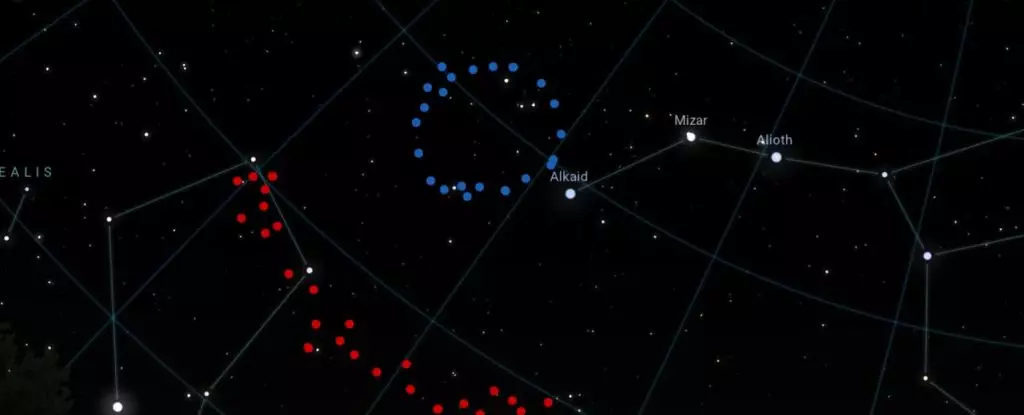A colossal and enigmatic structure in the distant Universe is causing astronomers to reevaluate their understanding of cosmology. Recently, astronomers discovered a massive and nearly perfect ring of galaxies, measuring approximately 1.3 billion light-years in diameter, that defies any known structure or formation mechanism. This remarkable structure, known as the Big Ring, may necessitate revisions to the standard model of cosmology. This article examines the implications and potential explanations for this perplexing discovery.
Led by astronomer Alexia Lopez of the University of Central Lancashire, this groundbreaking discovery was revealed during the 243rd meeting of the American Astronomical Society. Interestingly, this is not the first extraordinary find by Lopez and her colleagues. In 2021, they uncovered another massive structure called the Giant Arc, located in the same region of the sky and at a similar distance. Even at that time, the Giant Arc baffled astronomers. Now, with the discovery of the Big Ring, the mystery deepens further. Lopez acknowledges, “Neither of these two ultra-large structures is easy to explain in our current understanding of the universe.” The sheer scale, unique shapes, and their proximity within the cosmos raise vital questions that demand answers.
One possible link between the Big Ring and known structures in the Universe is the concept of Baryon Acoustic Oscillations (BAOs). BAOs are immense circular cosmic configurations comprised of galaxies dispersed throughout the cosmos. Essentially, these structures represent the frozen remnants of sound waves from the early Universe. Unlike BAOs, the Big Ring possesses a distinct corkscrew shape that appears as a ring when observed from a particular alignment. This perplexing structure defies our expectations and leaves us grappling with the question: What exactly is it? Furthermore, how does it challenge the Cosmological Principle, which posits that space should appear uniform in all directions and regions?
Apart from its unusual shape, the Big Ring deviates from the theoretical size limit imposed by cosmologists. The current understanding predicts that structures larger than 1.2 billion light-years should not exist. However, both the Giant Arc and the Big Ring surpass this threshold. The Giant Arc is nearly three times larger, and the circumference of the Big Ring is comparable to the length of the Giant Arc. This discrepancy in size challenges the fundamental assumptions of our cosmological model, prompting us to consider alternative explanations.
While the size of these structures presents one obstacle, their existence also raises questions about the framework of cosmology itself. Although our current model aligns reasonably well with observational data, certain features remain challenging to explain. Consequently, alternative cosmological models have emerged to address these discrepancies. Notably, Roger Penrose’s conformal cyclic cosmology suggests an endless cycle of Big Bang expansions, which could potentially produce ring-like structures. However, it is important to note that Penrose’s model faces significant challenges of its own.
Another hypothesis posits that these structures may be manifestations of cosmic strings – topological defects in the fabric of space-time. These cosmic strings resemble imperceptible wrinkles with a width on the scale of protons, which emerged during the early Universe’s expansion. While there is limited physical evidence of cosmic strings, the theoretical foundations remain promising. Currently, the nature and significance of the Big Ring and Giant Arc remain unknown. While it is conceivable that chance arrangements of galaxies could generate such structures, the odds seem remote. Therefore, the best approach would be to search for similar galaxy arrangements dispersed across the Universe, hidden in plain sight. Lopez expresses her fascination, stating, “From current cosmological theories, we didn’t think structures on this scale were possible. We could expect maybe one exceedingly large structure in all our observable universe. Yet, the Big Ring and the Giant Arc are two huge structures and are even cosmological neighbors, which is extraordinarily fascinating.”
The recent discovery of the Big Ring challenges our understanding of the Universe and its evolution. This colossal and enigmatic structure, along with the previously discovered Giant Arc, defy conventional explanations and theoretical limitations. Astronomers and cosmologists grapple with these exceptional findings, questioning their implications and searching for plausible explanations. Whether they are anomalies or signs of a new cosmological paradigm remains uncertain. However, these discoveries epitomize the inquisitive nature of scientific exploration, pushing the boundaries of human knowledge and inspiring further investigation.


Leave a Reply